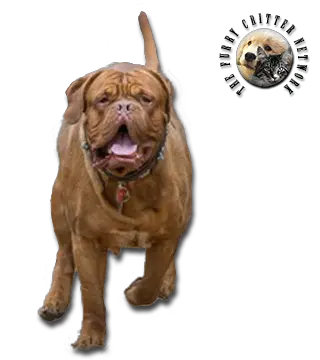Breed Standard
Head: Extremely capacious, angular, broad, relatively short. Viewed from the side, it has the shape of a trapezoid. The skull (perimeter equaling dog's height) is slightly convex. Strong stop. Forehead, which is wider than high, dominates the face. Deep, symmetrical wrinkles. Powerful, thick, moderately short, slightly hollow muzzle. Broad nose. Extremely powerful jaws. Undershot jaw (lower jaw protruding 0.5 to 2 cm, 0.1 to 1 in). Thick flews.
Ears: Small, slightly darker than the rest of the coat. Drop close to head along the cheeks.
Eyes: Oval, moderately wide set. Hazel to dark brown color in dogs with a black mask, lighter color permissible in dogs with a red mask.
Body: Powerful. Very strong, almost cylindrical neck with dewlap. Powerful, deep, broad chest. Ribs well sprung. Broad, muscular back. Belly tucked up. Slightly sloping croup.
Tail: Very thick, carried low with the tip reaching no further than the hocks.
Hair: Fine, short, smooth, and soft.
Coat: Fawn or dark auburn with a red or black mask. Good pigmentation preferred. Small white markings on the forechest and feet are permissible.
Size: Dog: 60 to 68 cm. (23.5-27 in).Bitch: 58 to 66 cm. (23-26 in).
Weight: Dog: at least 50 kg. (110 lb).Bitch: at least 45 kg. (99 lb).
History
The Dogue de Bordeaux, one of the oldest breeds in France, is the only mastiff of French origin. This dog may be descended from the Roman Molossus, the Spanish Mastiff, and others. During the Middle Ages, the breed was used for hunting and dog fighting. In the eighteenth century, Buffon described it as the Dogue d'Aquitaine. This breed was long known as the "butcher dog" because butchers often selected this breed to protect their homes. He has also been known as the "Turk dog" in reference to his Asian ancestors. An official standard was recognized in 1926 after the breed had been crossed several times with mastiffs.
Behavior
This former fighting dog is an excellent guard dog that vigilantly protects the home with courage, though not aggression. The French Mastiff does not like to socialize with other dogs. This gentle, calm, sensitive dog forms a strong bond with his owner and is very affectionate with children. He rarely barks. This breed detests solitude and lack of activity. This dog must be exceptionally well-trained in order to keep him under control.
The French Mastiff is not suitable as a house dog. He needs space and exercise. No special care of the coat is required.
Function
Guard and Defense Dog, Pet.
Health
While larger breeds of canines tend to have shorter life expectancy, the life expectancy of the Dogue is still shorter than even breeds of comparable or larger size. According to data collected by the Dogue De Bordeaux Society of America, the average lifespan of the breed is 5 to 6 years. A veterinary database in the UK showed similar figures. In the American survey, the oldest dog in the record was 12 years old. However, the acting dog who played Hooch in the 1989 film, Turner and Hooch, died at the age of 14. The Society is actively recording dogs that are 7 years old or older to celebrate the longer-lived dogs.
Because of its brachycephalic head, the Dogue can be affected by breathing problems. Some may be intolerant of heat or exercise as a result. The brachycephalic head shape can also encourage ectropion—an outward rolling of the lower eyelid which can lead to conjunctivitis (eye inflammation) and bacterial infections. Under the UK Kennel Club's Breed Watch system, the Dogue is classed as a Category 3 breed (formerly High Profile Breed), meaning it is a breed "where some dogs have visible conditions or exaggerations that can cause pain or discomfort."
Aortic stenosis is a disease of the heart valve in which the opening of the aortic valve is narrowed. Symptoms include exercise intolerance, exertional syncope (fainting from physical exertion) and sudden death. One study suggests a high predisposition in the breed. No severe cases were found in adult dogs, and most moderate to severely affected dogs died before one year of age, leading the authors to speculate that the disease is more severe in the Dogue than in other breeds.
Another heart problem in the breed is dilated cardiomyopathy, a condition in which the heart becomes weakened and enlarged and cannot pump blood efficiently. Some affected dogs may die suddenly without showing any signs of problems. Others may die from congestive heart failure after several weeks or months. Affected dogs are often euthanized at an early stage to avoid suffering.
An estimated 5% of dogs may be affected by footpad hyperkeratosis, a thickening of the footpad and sometimes nose. Lesions usually occur at the age of 6 months. X-rays submitted voluntarily to the Orthopedic Foundation for Animals shows that more than 50% of Dogues in the database are affected by hip dysplasia. Over 21% are affected by elbow dysplasia. Approximately 3% of Dogues suffer from retinal dysplasia. Patella luxation affects around 2% of Dogues.






